by Dot Cannon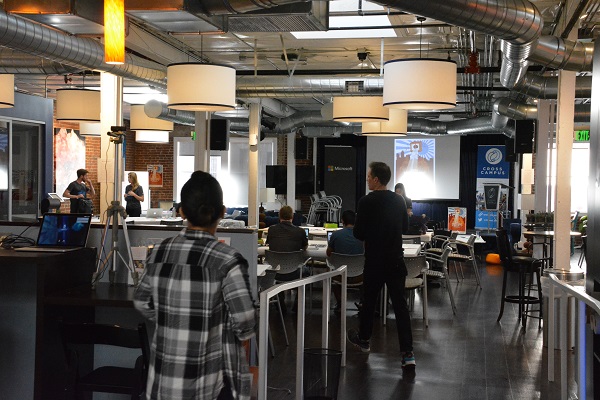
At first, the atmosphere appeared subdued.
It was 8 am, Sunday, April 25th, 2016, at Pasadena’s Cross Campus facility. Day 2 of NASA’s fifth annual International Space Apps Challenge was starting.
Some team members in the Space Apps Pasadena location had been onsite until midnight on Saturday.
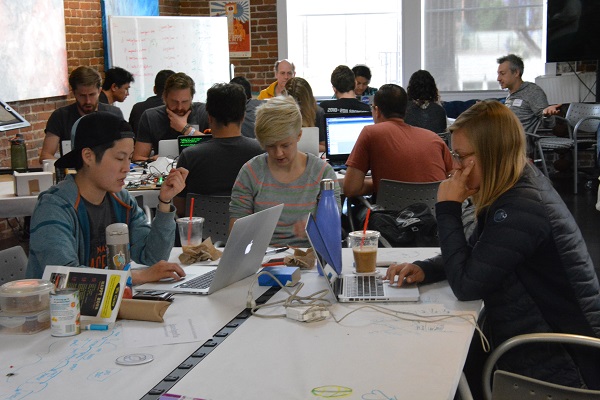
Under the seemingly-quiet surface, though, was a lot of activity. In just five hours, the judges would decide on this year’s International Space Apps Challenge winners.
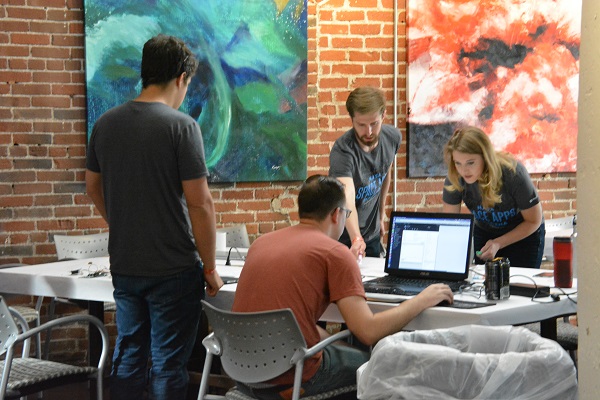
Worldwide, the International Space Apps Challenge was happening in 160 locations. Sixty-two countries were participating in this free hackathon, according to NASA Chief Technology Officer for IT Deborah Diaz. The goal: to collaborate, in teams, to solve problems. These could be anything, from issues aboard the International Space Station to coming up with an app to raise cows. The teams had one weekend–from Saturday morning to early Sunday afternoon–to create their projects, using NASA open data.
By Sunday morning, Deborah said, International Space Apps teams had registered for a total of more than 400 projects, worldwide, for consideration in the afternoon’s judging sessions.

“But we expect it to be more like 500 (when everyone’s registered),” she added. “They have until noon today to register their projects for the competition.”
In the Pasadena location alone, seventeen projects were on the team sign-up sheet.
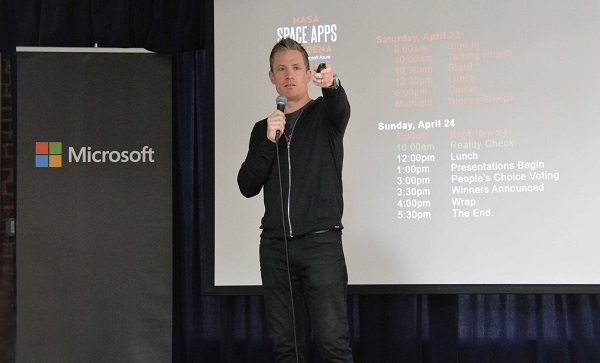
“You guys all showed up early and are right back at it, which is awesome,” said NASA Space Apps Pasadena organizer Joe Brisbois. “In just a few hours, you’ll be up here onstage, presenting your project to all of us.”
In space terms, teams were t minus five hours–and counting. Provided resources, for the projects, included Microsoft’s Azure cloud services, Intel® Edison boards and Socrata’s data platform, which powers NASA’s
And rather than being all-science-and-math crews, teams were highly eclectic. Storytellers, artists and entrepreneurs were welcome at the table.
“Everybody’s kind of taken their own place, so it’s going well,” said Boom Clap team participant Julie Knight.
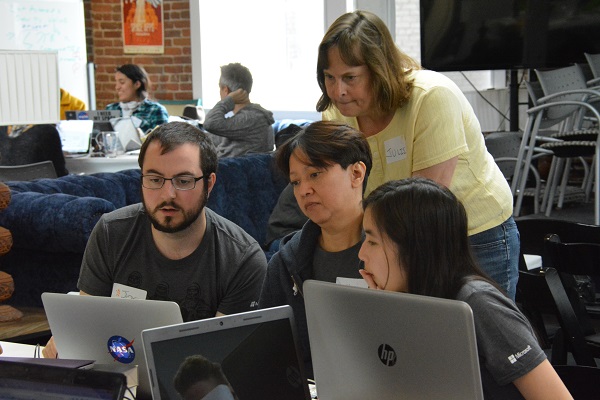
Embedded as a member of Boom Clap, this particular (nonscientific) reporter worked on the presentation script, as the team completed their coding. The project: a system to educate the public on sonic booms.
The morning seemed to pass at warp speed. Suddenly, it was noon.
“The good news is, the food is here…please help yourself. The bad news is, you have 45 minutes to get your presentations ready,” said Joe Brisbois.
Once one o’clock arrived, competition judges–from NASA, Intel®, Microsoft and Socrata–had some tough decisions to make! At stake were awards, including “Best Use of Data” from Socrata, Microsoft’s “Best Use of Azure”, and Intel’s “Best Use of Edison” (their development board). Those are in addition to the first- and second-place winners, and the “People’s Choice” award.
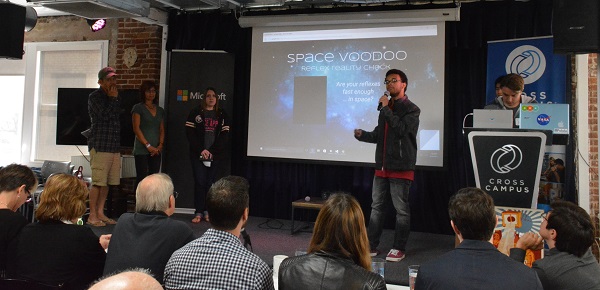
Seventeen teams took to the stage, that afternoon in Pasadena. These included two one-person teams.
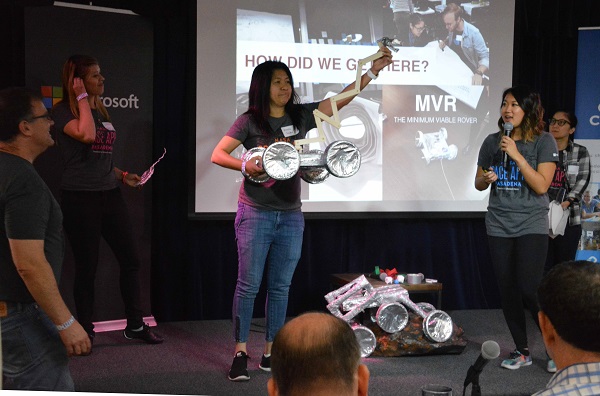
The first presenters, “Team Hello Kitty Astronauts”, introduced the audience to “Risky the Rover”. This is a prototype for a small rover that can travel into crevices and risky surfaces on Mars.
Doing justice to all the creativity and imagination, from that afternoon, would be impossible in this space. Here are just a few highlights:

These rover wheels are origami-constructed, to deploy easily!
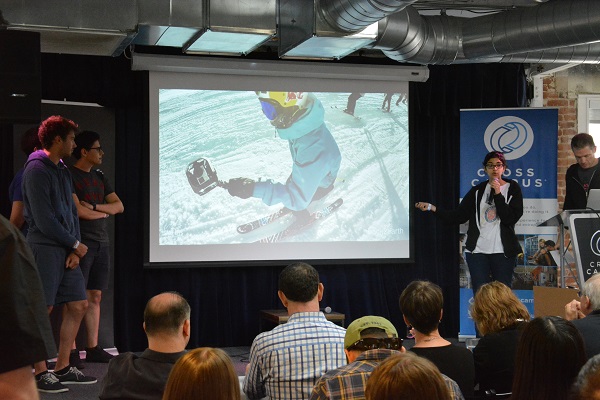
This is a virtual-reality system, designed to simulate the sights, sounds and even the scents of home for astronauts aboard the International Space Station. According to astronaut and former ISS commander Doug Wheelock, ISS crewmembers exercise about two hours each day on a treadmill and stationary bike. With this system, a routine could become a ride along a beach, a walk through a forest–or, possibly, a ski run through fresh powder.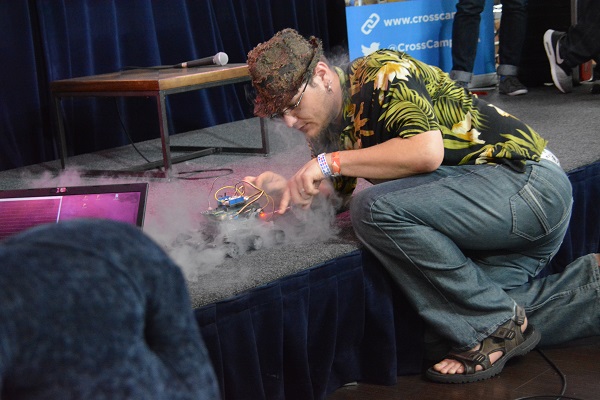
“Sorry,” apologized a member of Team Stardust, as his group’s “Jarvis Sensor System”, designed to detect space dust, demonstrated that it worked well!
Joe Brisbois commented on the difference in the 2016 competition. “Last year, mostly software products resulted from Space Apps,” he said. “This year, it’s hardware.”
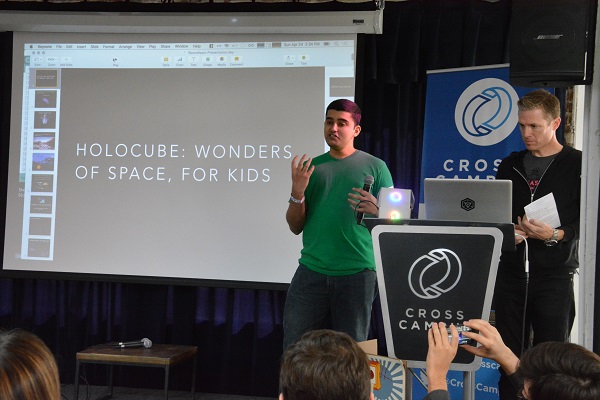
A moment the audience especially enjoyed, came towards the end of the presentations. One-person team Ankush Dhakar presented his invention, the “HoloCube”. This, he explained, is an educational puzzle box.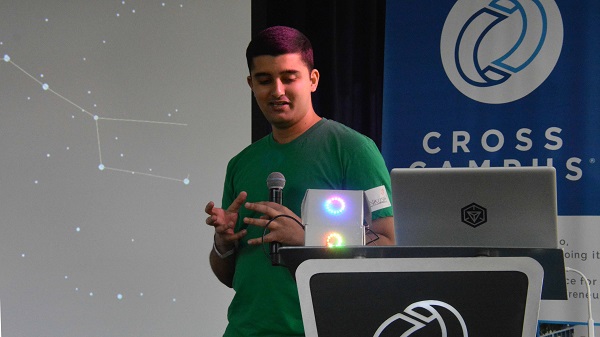
“When kids solve puzzles, interesting things happen,” Ankush said. “One of them is, a constellation appears on their ceiling. My vision is to make kids’ rooms look like this.”
“People’s Choice!” yelled someone from the back of the room.
But, perhaps, the most telling reaction came from an audience member, approximately nine years old.
“Is it up for sale?” the young man asked. When Ankush answered, “It will be,” the inquirer cheered, “Yes!”
Shortly after that, it was time for some decisions.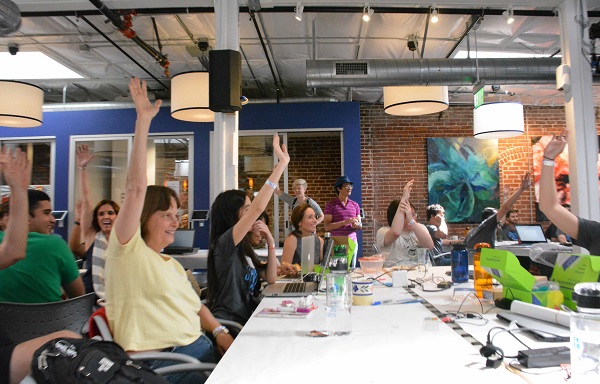
The judges adjourned to another room while the audience registered a People’s Choice vote. Not surprisingly, this nearly-unanimous choice was for…
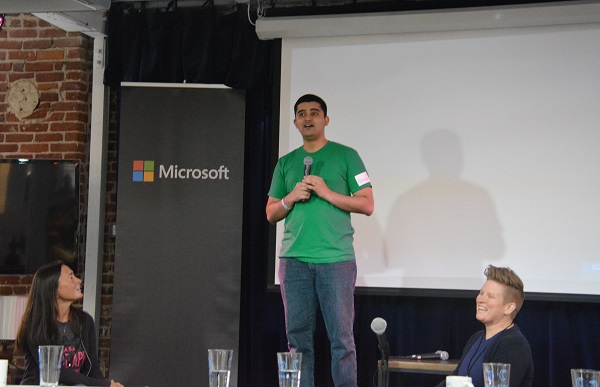
…HoloCube, for which Ankush says he’ll soon be launching a Kickstarter campaign.
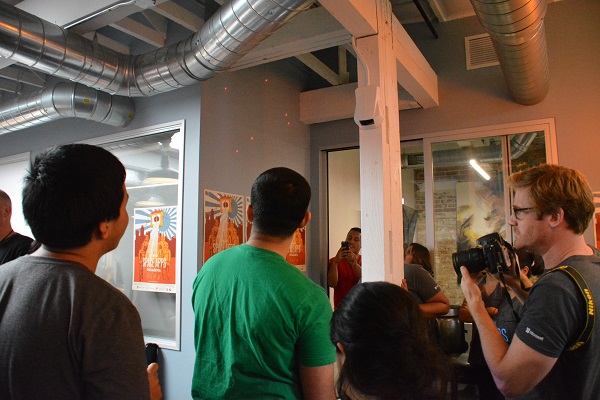
Following the People’s Choice vote, he was surrounded. All the “big kids” wanted to see it work!
A few minutes later, the judges returned. Several projects won more than once.
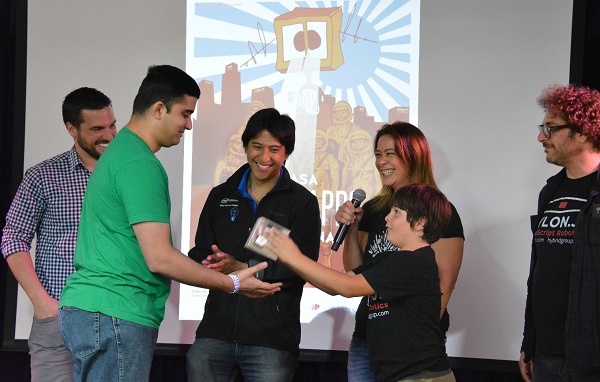
HoloCube was a second-time winner–capturing Intel’s award for “Best Use of Edison”.
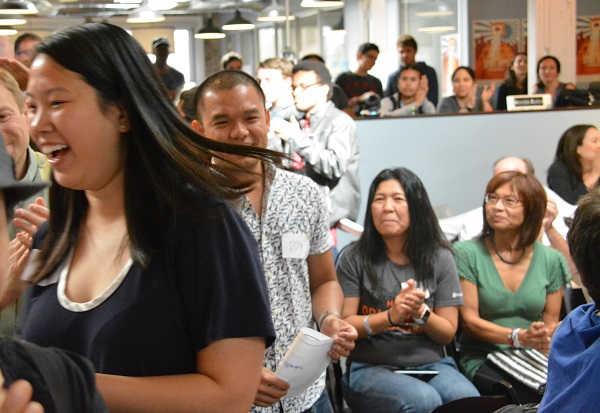
Microsoft’s “Best Use of Azure” competition ended in a tie, with both Scintilla and Team Stardust winning. (Scintilla is a system which collects real-time data on air pollution, and calculates a real-time air quality score for any location on earth.)
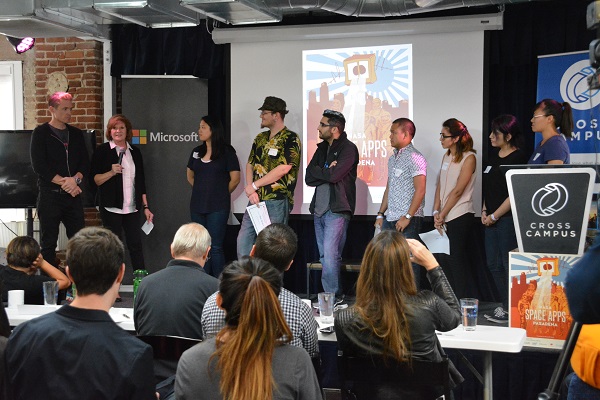
Team Stardust went on the win the 2016 Global Challenge second-place award for their “Jarvis Sensor System’, which can be used to monitor environmental factors and their effects on allergies both in space and here on earth.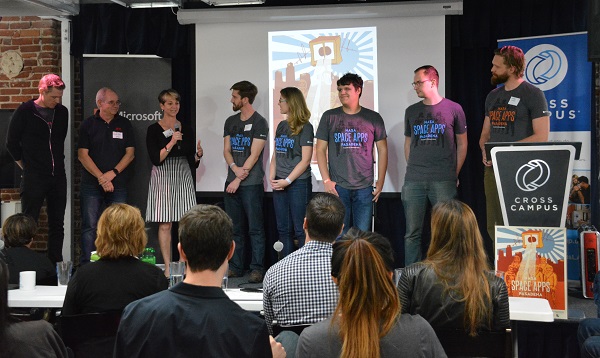
And the first-place 2016 Global Challenge winning team: Scintilla. Prizes included a tour of JPL and the opportunity to be on-hand for a launch at the Kennedy Space Center.
“Great job, everyone. See you next year,” said Joe in his closing remarks.
Participants began breaking up into small groups, networking and enjoying the refreshments.
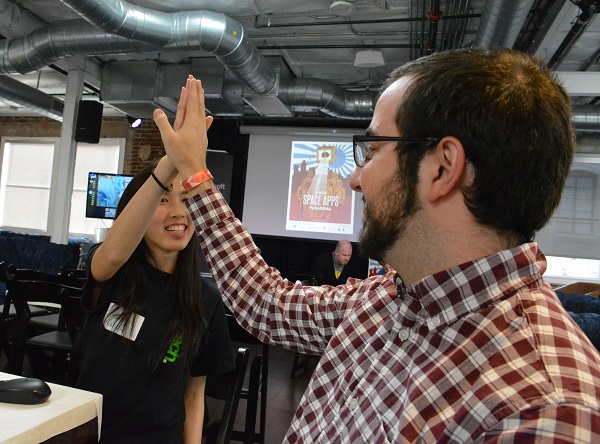
NASA International Space Apps 2016 was a great event–especially for those of us who have never excelled at science.
Inclusive innovation, involving arts people and entrepreneurs, may be one of the most exciting technological developments we’ll ever see.
Didn’t get to a NASA 2016 International Space Apps Challenge? You don’t have to wait till 2017 to get involved in creating the future! Here’s a link to NASA’s new “Datanauts” problem-solving community. And like the Women’s Data Bootcamp, this is geared towards attracting data newcomers!
